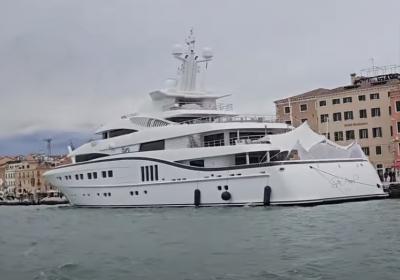Exclusive: Billionaire yacht link to British Council overshadows 60th Venice Biennale

VENICE -- With massive destruction, and a huge displacement of people continuing around the globe, within Meloni’s Italy, this year’s provocatively entitled Stranieri Ovunque (Foreigners Everywhere) at the Venice Biennale was always going to be politically charged.
What started as an anniversary present to King Umberto in 1895, the Venice Biennale has been attracting artists with their passions, benefactors with their money, and politics from around the world ever since. This year 88 countries are represented in the collective exhibition spaces as well as in the national pavilions in what has become the ‘Olympics of the art world’. But you can’t keep politics or big bucks away from either art of sport, and like it’s eponym, the Venice art show has also faced controversy and criticism throughout the years.
The Biennale first became politicised by the fascist government in the 1930’s, and Mussolini’s personal propaganda machine with art explicitly showing military dominance. In the 60s, it became a symbol of political and cultural unrest, with protestors occupying the pavilions and turning the art to face the wall. In 1974, the exhibition “antifascist”was a direct response to Pinochet's military coup in Chile, and in 1977, the ‘Biennale of Dissent’ showcased artists from the Soviet Union who were not sanctioned by the state. In 1993, German artist Hans Haacke smashed the stone floor of his country’s pavilion where Hitler had stood in 1934.
This year, the Russian pavilion has been loaned to Bolivia, where Andean weaver Elvira Espejo Aycawho invites us to muse over traditional yarn making techniques while the cynical amongst us can only think of Bolivia’s huge lithium reserves. And despite being given a petition to ban Israel, Italy’s culture minister Gennaro Sangiuliano gave it the go ahead calling the petition ‘shameful.’ Fortunately, the Israeli artist had better decision making skills and the pavilion remains closed.
With the emphasis on migration and marginalised communities, art by indigenous artists is everywhere, and it’s no coincidence that most of the major European players have chosen representatives that inextricably link them back to an often ugly past. Peruvian born Sandra Gamarra Heshiki representing Spain, reminds us that most of our churches and museums have been formed from plunder, privilege, and violence. An uncomfortable premise delivered via the medium of clever paintings and a beautiful polyptych which higglights notions of accumulation and ostentation. In the Italian pavillion, Massimo Bartolini’ adopts a more self reflective approach and asks us ‘To Hear.'
Indigenous artist Jeffrey Gibson gives us a colourful eyeful of textiles in the U.S. Pavilion and a juxtaposition of traditional native dance with modern DJ music in a catchy, visually delightful foot-tapping videoscape.
Brazil reclaimed it’s ancient name and changed it’s pavilion to Hãhãwpuá, and gave a voice to it’s 300 indigenous peoples. A television perched on top of a mound of earth transmits a chilling reminder that we are burning what the earth took thousands of years to create and releasing it into the environment, with a warning ‘you are on the path to creating your own extinction’.
A welcome reprieve came from Martinican artist Julien Creuzet, who has created one of the most beautiful experiences in the French pavilion with an installation that features a calming underwater utopia and hanging sculptures that make you feel like you’re walking through an enchanted space.
Next door the water theme continues in the British pavilion, with Ghanaian born John Akomfrah’s Listening All Night To the Rain, with bodies of water as the central motif.
While attentions was focused on concepts and artistically arranged metaphors inside, in the Venetian Lagoon outside, a Supersized yacht was drawing a different kind of attention.
With the owner being revealed as Indian born Indonesian Sri Prakash Lohia, who is the father-in-law of the British Council’s ambassador to the Biennale, Aarti Lohia, the inappropriateness of such an environmentally damaging vessel next to an art show desperate to showcase its collective conscience was simply too much for some onlookers.
“The presence of this yacht is so incongruous, so contrary to the spirit of much of the art at the Biennale, that at first I wondered if it might be an elaborate piece of performance art” said UK resident Johnny Ealing, “But no, it’s just a gazillionaire making a mockery of the whole event”
A keen art collector and benefactor, Prakash Lohia is also the billionaire founder of Indorama Corporation, one of the largest petrochemical companies on the planet, an industry that not only emits a significant amount of carbon dioxide into the atmosphere, but also produces huge amounts of waste, and has been accused of contaminating local water supplies. An ongoing environmental pollution suit brought by a local community against Indorama Eleme in Nigeria has yet to be decided. The company has also come to the attention of The International Labor Rights Forum accused of forced child labour and last year the Uzbek Forum for Human Rights filed a complaint on behalf of farmers who had lost their livelihoods due to alleged illegal land confiscation and exploitative contracts that include minimum price for cotton.
Money and politics have always played a major part in the art world, but Brazilian curator Adriano Pedrosa, has made an admirable attempt at bringing together the marginalised and the celebrated, the haves and the have-nots. The exhibition is less about chiding us for the past and more about collectively appealing to our empathies and a promise to do better.
With the world of art world displaying such a powerful collective conscience at this years Venice Biennale, that may include where it get’s its money from in the future.
The 60th Venice Biennale is open and running until Nov. 24.
jp-lw-js


© COPYRIGHT ITALIAN INSIDER
UNAUTHORISED REPRODUCTION FORBIDDEN


